Both are sources of renewable energy for the nation, as they have the potential to raise human capital, secure our democracy and amplify India’s soft power.
Unfortunately, the quality of children’s literature and the quantity that children read is a bit of a chicken-and-egg problem. Which needs to be fixed first? Solving a chicken-and-egg problem is impossible without becoming vegetarian—or, in other words, doing something different.
The sideshow status of children’s literature at major litfests in India reflects a poverty of ambition, quality and attractiveness in our supply of books. Our neglect of children’s literature is painful, given that this industry’s products and services are at the core of culture, learning and the exchange of ideas.
If we don’t change, we will have to scale back some if not all of our ambitions. The Indian kid-lit market is just above ₹700 crore—the size of a small pharmaceutical company. Even small Spain and France are around five times of India, with the US, UK, China, Australia, Germany and Japan way ahead.
At No. 1, the US kid-lit market, though declining, is around 30 times that of India. Average kid-lit spending in the US and India is ₹20,000 and ₹20, respectively, per school-age child. Some of this gap can be explained by differences in prosperity and population, but there is more going on.
This year, our ₹80,000 crore central education budget is the highest ever, but could do with diverting 25% to reading as a national priority, removing the National Council for Educational Research and Training, National Book Trust and Children’s Book Trust from the politics of book access.
Children’s literature cannot change the world, but it can and should change itself to cope with it. Kid-lit in India is subject to that accounting monstrosity, LIFO or ‘last in, first out.’
Kid-lit was late to arrive in India, and with the dwindling of print media, bookstores and libraries, space for children’s literature across formats has shrunk.
India has a rich and diverse oral tradition, where stories were narrated rather than written down and passed along by grandparents, and this may have contributed to the slow growth of children’s fiction and publishing.
The content is not lacking; the will and creativity to put it in a form that would appeal to young minds is. Supplemented by reading challenges, book prizes and fellowships, focused litfests for children could change this.
The long shadow of Nehru’s view of the National Book Trust being a ‘book hospital’ for our young lives on in today’s view of children’s books being mostly textbooks.
Most are of poor quality with limited and outdated content that neither feeds the imagination nor informs, but narrowly prepares students for assessment.
The ratio of literature-to-textbook sales in India stands at 5:95—far lower than Japan’s at 90:10 (the world’s highest), the US’s at 70:30, and Korea’s and the UK’s at 60:40.
Textbook publishers and distributors have become printers, without the magical touch of commissioning, editing and nurturing authors. Ignoring literature and focusing merely on textbooks limits the development of a young mind’s creative engagement with the world.
Research suggests that seeing affirming views of identity in books defines children’s beliefs of how the world perceives them, which has led to the global emergence of African-American, Hispanic and Chinese literature. The politics of language in India, however, seems to be crowding out the real crisis.
Physicist Heisenberg’s ‘uncertainty principle’ broadly says that the very act of measurement can change the reading we get. At a non-sub-atomic level, this is defied by 20 years of ASER studies that show our low literacy indicators—50% of fifth grade children cannot read second-grade text—have worsened instead of getting better over time. India has a learning problem that clearly stems from a reading problem.
Our hesitation to participate in PISA assessments that serve as learning benchmarks globally is understandable, given our last poor showing 15 years ago, when India ranked second lowest among 73 countries, just ahead of Kyrgyzstan.
PISA establishes leisure reading as the greatest indicator for higher scores, and yet writers and editors of children’s literature get paid a pittance, resulting in a double whammy of worsening quality of children literature and thoughtless oversimplification of textbooks.
To read widely with interest and curiosity as a child or young adult is to acquire the ability to dream, imagine and create, while imbibing ideas, values and a sense of the world beyond one’s window.
Reading for leisure is entertainment, but it also enhances communication, language and employability skills. The quality of children’s literature and the quantity of children’s reading are intertwined. When one does well, so does the other. And when they both do well, India will be unstoppable.
#Childrens #literature #generator #human #capital
